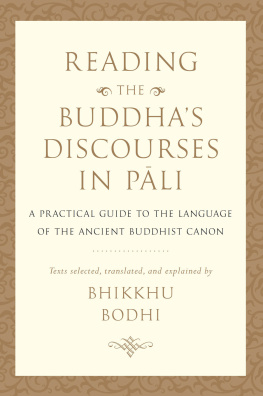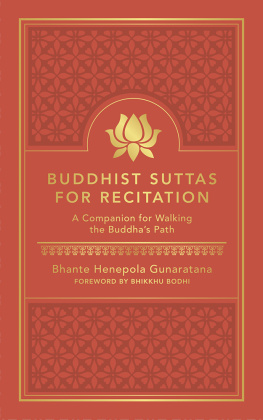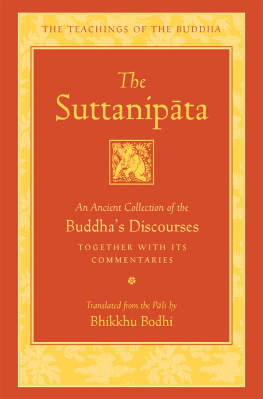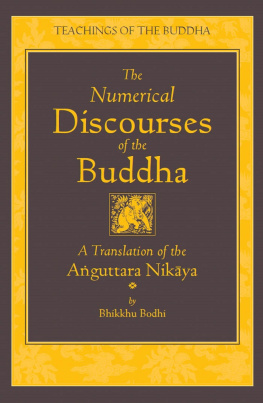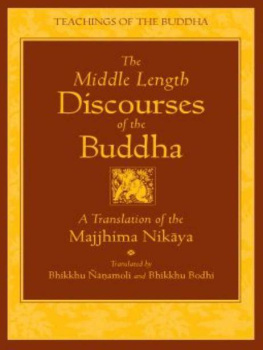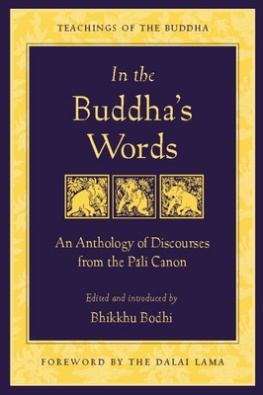THE SUTTA-NIPTA
THE SUTTA-NIPTA
Translated by
H. Saddhatissa

First published in 1985
Published in 1994 by
Curzon Press
Transferred to Digital Printing 2003
by RoutledgeCurzon
2 Park Square, Milton Park,
Abingdon, Oxon OX14 4RN
RoutledgeCurzon is an imprint of the Taylor & Francis Group
Curzon Press Ltd 1994
Reprinted 1998
All rights reserved. No part of this book may be reprinted or reproduced or utilised in any form or by any electronic, mechanical, or other means, now known or hereafter invented, including photocopying and recording, or in any information storage or retrieval system, without permission in writing from the publishers.
British Library Catalogue in Publication Data
A CIP catalogue record for this book is available from the British Library
Library of Congress Cataloguing in Publication Data
A catalogue record for this book has been requested
ISBN 0700701818
CONTENTS
Only a handful of translations of the Sutta-Nipta have been made in English but these are, doubtless because of their metrical rendering, generally archaic and stilted in expression; moreover, they are out of print.
I was persuaded to prepare a prose version which would convey the spirit of this important text in contemporary language and, it is hoped, stand the test of time more effectively than its predecessors. The present version is, therefore, presented for the consideration of readers who may find traditional interpretations inhibiting.
During my time at the universities of Benares (India) and Toronto (Canada) I taught the Sutta-Nipta to undergraduates there. It was at this period that I began the first draft of this work, the first four chapters of which have been serialized in Buddhist Quarterly (now Buddhist Forum) the journal of the British Mahbodhi Society. It should be understood that it is not a strict translation but rather a rendering of the spirit of the suttas. In particular, I have abbreviated where there are frequent repetitions in the original.
In this task I must express indebtedness to three friends who polished the language and helped prepare the final manuscript: Robert Barnett (grandson of the late L.D. Barnett, Professor of Sanskrit in the University of London and Keeper of Oriental Printed Books at the British Museum); Dr P.D. Premasiri of the Department of Philosophy, University of Peradeniya (Sri Lanka); and Russell Webb (Honorary Secretary of the British Mahbodhi Society, London Buddhist Vihara).
| London, September 1985 | H. SADDHTISSA |
The canonical texts of the Theravdin school of Buddhism (the predominant religious tradition of South-East Asia and well represented in the West), collectively known as the Pali Canon, are divided into three main sections: Vinaya (the disciplinary rules and procedures governing the behaviour and daily life of the monks), Sutta (the discourses of the Buddha or his foremost ordained disciples addressed to both monks and lay followers) and Abhidhamma (the developed psychological writings which are generally acknowledged to post-date the historical Buddhas lifetime, c.560-c.480 B.C.). All these texts were transmitted orally and only committed to ola leaf manuscripts in modern Sri Lanka (ancient Ceylon) in the first century B.C.
The collection of suttas is, in turn, sub-divided into five sections: Dgha Nikya which comprises long, mainly narrative discourses. Majjhima Nikya medium length discourses which are generally regarded as the most important from the standpoint of the practical application of the Dhamma (or Doctrine/Teaching of the Buddha). Sayutta Nikya detailed Dhamma prescriptions arranged in subject order.
Aguttara Nikya compressed narrative discourses which expound the Dhamma in numerical sequences.
Khuddaka Nikya which comprises fifteen individual books of which the best known is the Dhammapada (in over thirty English translations) and one of the most formative and influential, the Sutta-Nipta.
Vernacular translations from Pali (the common tongue related to a Prakrit language in which the Buddha was reputed to use) as opposed to Sanskrit, the one-time preserve of the Indian brahmins, have been produced in Indian and South-East Asian languages and, during the last 150 years, Japanese and European languages. However, it is only in English that the Canon has appeared almost in its entirety, due primarily to the efforts of the Pali Text Society (f. 1881) which is currently arranging for the complete translation of the traditional Commentaries.
Despite the foregoing, no completely lucid English translation of the Sutta-Nipta has been made. A number of analytical studies have been produced by Pali scholars who have carefully examined the texts linguistic and historical features and its place in the Canon.
From such researches we can recognize four stages of literary development:
The (philosophical) Ascetic stage
The (disciplinary) Monastic stage
The (religious) Moralistic stage
The (commentarial) Legendary stage
The first stage, embodied by the oldest strata of the Sutta-Nipta (i.e. I 3, IV and V), was represented by the Buddha and his fellow homeless ones who led an eremitic existence. His teaching was austere and stoical so as to lead to steadfastness of purpose and endeavour which would culminate in the final release from the unsatisfactoriness of mundane life the mental state of Nibbna (Nirvna) which could (and can) be attained here and now. Moderation and self-control were extolled; desire, prejudice and ill-will were repudiated; traditionalism was eschewed, despised, and rigid rules were regarded as fetters, as hindrances to that personal liberty of the spirit which is the hall mark of permanent Deliverance.
The specific text under consideration combines numerous features which make for a timeless and wider appeal than has hitherto been allowed for it: an analysis of psychological motivations which provides a refreshingly modern insight into human nature; an emphasis on mental detachment from the distractions of life; empirically-orientated philosophy which is subject to verifiable realization; fundamental doctrines of the Dhamma presented in a non-scholastic, unsystematized form; rationally-based exhortations to lead a balanced, ethical life; biographical sketches of the Light of Asia and vignettes of daily life in ancient India. All these features are couched in dialogue form, narrative prose or devotional verse, devoid of pedantry, niggling rules and regulations, repetitive or stereotyped stock formulae which appear elsewhere in later strata of the canonical texts.
The whole text conveys an atmosphere untrammelled by inhibiting conventions and with an emphasis on positive striving towards the desired goals of spiritual freedom and non-attachment. With its direct appeal to individual effort and self-discovery, as opposed to current commercialized and populist blandishments, this straightforward didactic work has a particular relevance today when a new generation is seeking a practical path leading to a purposeful life.
The numbers in parenthesis at the right of each verse correspond with the consecutive numbers of the stanzas as they appeared in the original text.
The monk who discards all human passions is compared to a snake that casts its skin
He who gives up anger which has arisen, as the snake poison diffused in the body is removed by antidotes, that monk gives up the Cycle of Existence as the snake sheds its old, decayed skin.
(1)
He who has completely destroyed lust as one cuts off a lotus flower in a lake, that monk...
Next page

